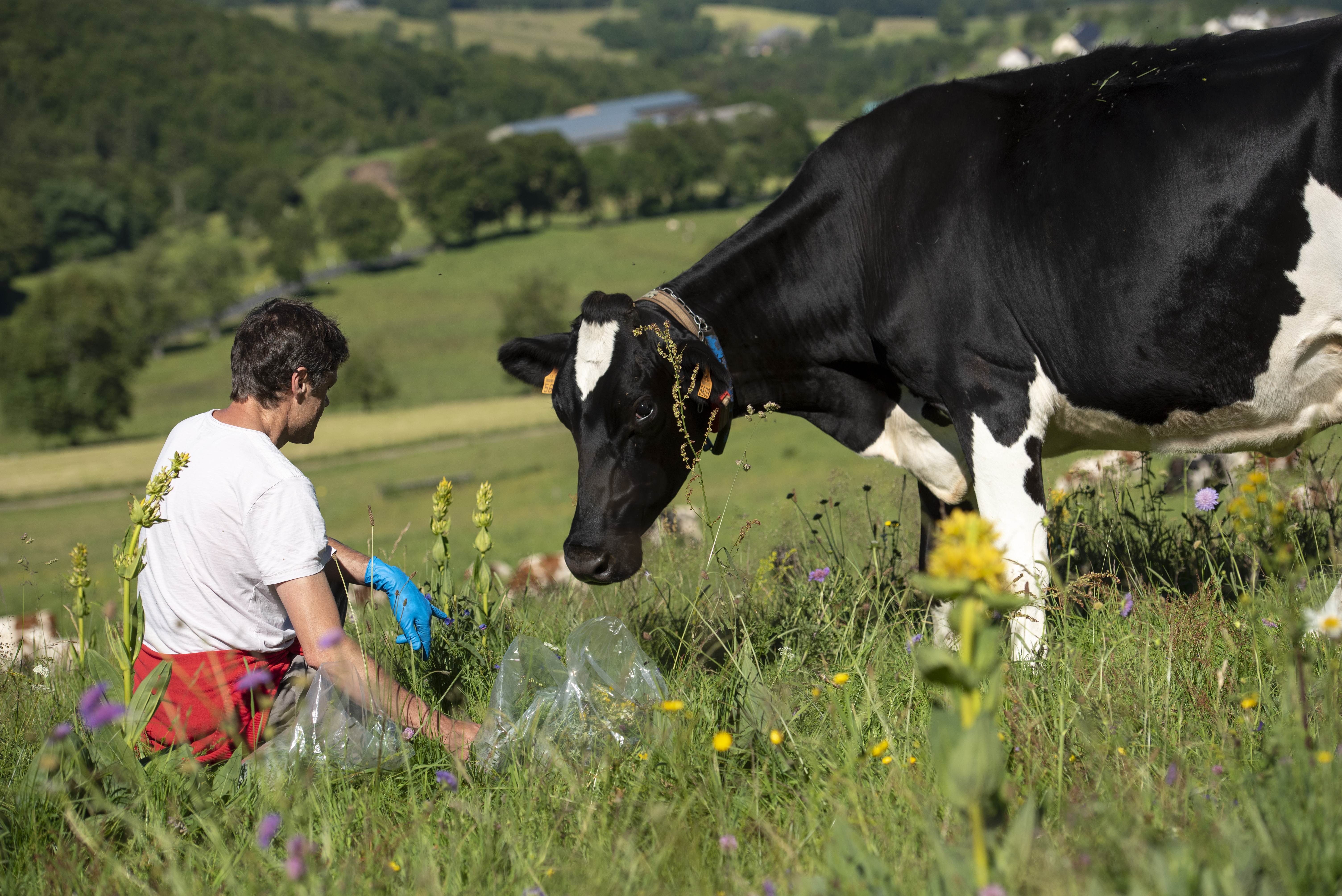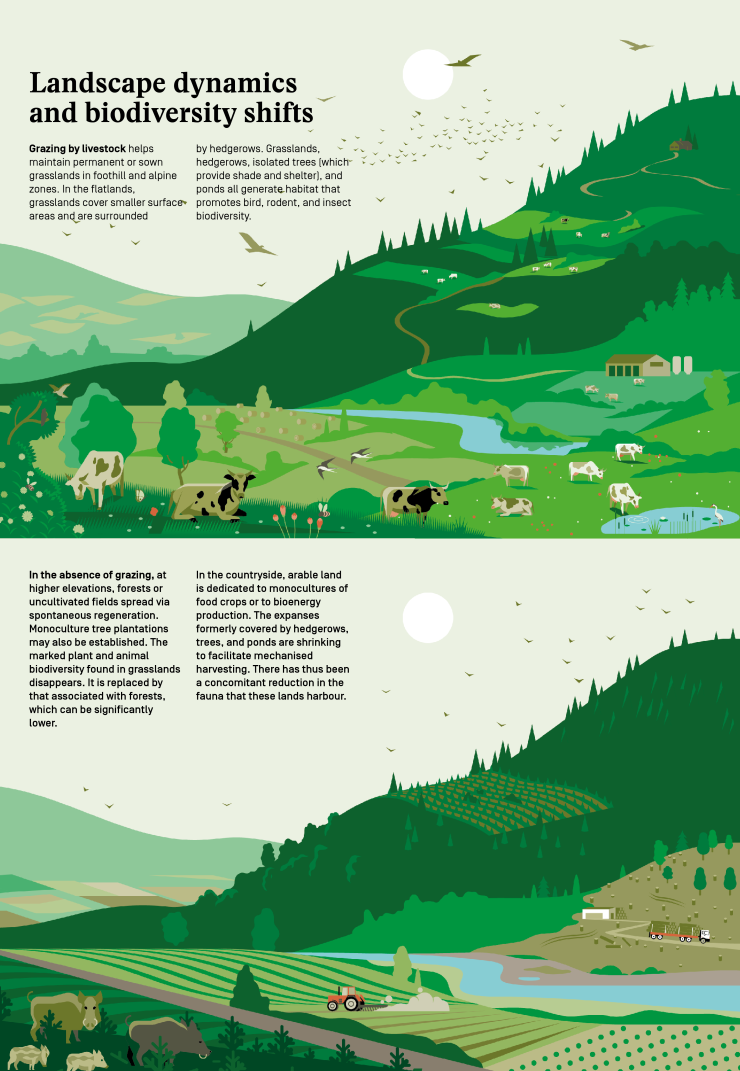Ressources dossier
AgroecologyGrass-based livestock farming, raring to succeed
Published on 24 January 2023
Research has confirmed that grass provides cows with a ration that is fully balanced in energy and proteins. Grazing is also a more affordable approach for farmers. Furthermore, “fresh grass meets 90% of a cow’s hydration needs. For example, a cow drinks 10 litres per day when grazing versus 60 litres per day when consuming maize silage”, notes Jean-Louis Peyraud, a special adviser at INRAE's Scientific Directorate for Agriculture. When processed for longer-term conservation (i.e., hay, grass silage, baled grass), grass declines in nutritional quality. Farmers must supplement their herd’s diet with concentrates, especially grain-based concentrates, in order to maintain milk production. The approach then becomes less economically attractive, especially since it is more challenging to harvest and store grass than maize silage. Grassland systems should thus maximise grazing. In addition, by using greater quantities of legumes, farmers can spend less money on mineral fertilisers. Furthermore, grasslands can be maintained without plant protection products. Savings are also achieved via lowered seed costs—grasslands are sown once every several years, or not at all in the case of permanent grasslands.

Strong potential for profitability
In France, farmers who utilise grass-based production systems can benefit financially if they become certified under certain regimes/labelling schemes, which often require that animals be grass fed. For example, in 2019, organic farmers could sell 1,000 litres of milk for €434, on average; the same quantity of conventionally produced milk went for €372.
It should be noted that various minor European initiatives are seeking to commercially categorise “grass milk” based on its origin and production conditions (e.g., labels for “haymilk” or “grassland milk”). Such could increase the decision-making power of consumers while also ensuring that farmers receive fair compensation relative to true production costs.
Diverse grasslands provide diverse environmental services
The environmental advantages of sown grasslands generally accrue the longer grasslands remain in place.
On grass-based livestock farms, there is a range of floristic diversity. “Farms can use three types of grassland for grazing and/or for mowing. In the latter case, fodder can be conserved as hay, baled grass, or grass silage”, explains Luc Delaby, an animal husbandry scientist in the Joint Research Unit PEGASE. Legume grasslands are sown and last for short periods of time (1–3 years). They contain one or more species; most are 90% lucerne, which sometimes co-occurs with sainfoin or clover. Temporary grasslands are also sown but last for longer periods of time (5–10 years). They contain a broader diversity of grasses (e.g., perennial ryegrass, annual ryegrass, tall fescue, orchard grass), legumes, and various dicotyledons. Permanent grasslands are not sown. Instead, livestock farmers exploit the native flora specific to the soils and climatic conditions of their region. “These permanent grasslands are often characterised by plots that are highly rich in species (from 15 to more than 100). Their environmental benefits are thus enormous”, says Luc Delaby.
The environmental advantages of sown grasslands (e.g., biodiversity, carbon storage, water purification) generally accrue the longer grasslands remain in place. To promote agroecological practices, an agricultural competition was launched. Over the past 10 years, Prairies Fleuries has been granting awards to French farms whose livestock systems display the best balance between grassland floristic diversity, forage autonomy, and product quality. Grasslands also help limit soil erosion because they result in year-round plant cover.

High-quality dairy products
The more grass present in the ration, the richer the milk will be in vitamin A, vitamin E, ß-carotene, and omega-3.
The forage consumed by dairy cows has an impact on the nutritional and organoleptic characteristics of dairy products. As Bruno Martin, an animal husbandry scientist in the Joint Research Unit for Herbivores, explains, “Regardless of grassland origin, the more grass present in the ration, the richer the milk will be in vitamin A, vitamin E, ß-carotene, and omega-3. This milk also has lower levels of saturated fat compared to milk produced by cows fed corn silage.” To a lesser extent, similar effects are observed when animals are given grass in the form of hay or silage. “These compositional differences carry through into the final products, such as butter, cream, and cheese, influencing their flavour, colour, and texture”, says Bruno Martin. However, the effects of grass-based diets depend on grass developmental stage, the storage conditions experienced by winter forage (i.e., hay silage), and grassland plant diversity.
Benefits of grazing for animal welfare
Grazing can also improve animal welfare. It allows animals to freely express natural behaviours and food preferences. In addition, some grassland plants are rich in carotenoids and tannins. They have been shown to positively affect animal health by reducing the risk of mastitis or metritis. However, to optimally exploit grasslands, it is important to establish clear paths for animals to walk along and to plant hedges for shade.
Constraints and fine-scale management
Farmers must closely and precisely monitor grassland growth and species composition when implementing dairy production systems.
“Farmers must closely and precisely monitor grassland growth and species composition when implementing production systems where dairy cows graze on permanent or legume grasslands. It is also crucial that animal density (i.e., the stocking rate) match plot surface area if farmers wish to fully benefit from the grazing regime”, warns Luc Delaby. Such requires managing grass quantities, which vary greatly depending on climatic conditions (i.e., temperature, rainfall). Climate change is likely to render management even more challenging, given that extreme droughts and precipitation events will become increasingly frequent and intense. One strategy could be to sow certain types of species, such as those with deeper roots and greater resilience. Luc Delaby provides some reassurance: “It is important to remember that grass provides year-round ground cover and will grow more or less abundantly depending on the weather, which completely contrasts with annual forage crops, which are sown and harvested once a year. If the summer is too dry and a farmer has to resort to their forage reserves (i.e., hay, silage, haylage), they can compensate for the situation by producing grass late in the fall, over the winter, or even early the following spring. On the other hand, if a drought harms forage crop yields, a farmer will be forced to purchase rations for their livestock.”
Renewed interest in grass-based systems also means renewed interest in “hardy” livestock breeds that are well adapted to the environment, less bulky in stature, and able to do without concentrates. Highly productive breeds, such as the Holstein, generally do well in low-intensity, grass-based systems. However, their reproductive performance is sometimes impacted. Indeed, selection for certain traits such as size and milk production means that these breeds now struggle with milk production and gestation if they are not fed concentrates during their reproductive period. Grazing is the sole or mostly dominant system used in some countries, such as Ireland and New Zealand. However, in the lowlands and foothills of most of Europe, farmers employ mixed crop-livestock systems with lower levels of grazing, higher levels of annual forage crops (especially maize silage), and concentrate supplementation.
Farms are increasing in surface area, with pastures that are located farther and farther away from milking parlours. This shift has made grazing management more challenging, especially because herd sizes are generally increasing as well.
Practical constraints
In addition, as agricultural lands are being transformed into urban developments or transportation routes (i.e., roads, railroads), rural areas are disappearing and becoming fragmented. Since cows need to be milked once or twice a day, grazing becomes untenable given pasture distance. The result is less fresh grass in the cows' diets. Robotic milking systems have also led to a reduced use of grazing.
Livestock farmers are facing an additional challenge as farmlands are increasingly being dedicated to non-food crops (e.g., crops destined for energy production or green chemistry). Such crops may be more profitable in certain regions, driving up forage prices and thus threatening the economic balance of dairy farms. All these issues must be addressed when decision-makers develop and implement public policies.
A collaborative commitment to protecting the environment
Although there are some concerns to keep in mind, a well-managed grazing regime can benefit dairy farmers and the environment in distinct ways. The EU has codified certain goals in its Green Deal: a) becoming the first climate-neutral continent by 2050 and b) structuring the 2021–2027 CAP to encourage a return to grazing by providing direct aid to farmers that is conditioned on the adoption of agroecological practices (e.g., increasing plant cover diversity, reducing ploughing, and limiting the use of phytosanitary products). Additional subsidies may be granted based on the environmental and animal welfare services provided by grasslands and associated agroecological infrastructures. Alongside farmers and decision-makers, consumers have a determinant role in this economy: their purchasing choices support or reject grass-based production systems.
-
Sarah-Louise Filleux
(Send email)
Author / Translated by Jessica Pearce
Direction de la communication
